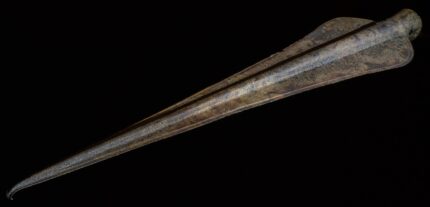A rare spearhead complete with surviving traces of its wooden shaft from the Late Bronze Age has been discovered on the Channel Island of Jersey. It dates to around the 11th century B.C. and is the largest and most complete spearhead ever found on the Channel Islands.
Metal detectorist Jay Cornick found the spearhead on Gorey beach last summer and had no idea it was so ancient. He thought it might be related to Mont Orgueil (aka Gorey Castle) which looms over the beach and originally dates back to the 13th century. He reported it to Jersey’s Finds Officer and Jersey Heritage experts examined and conserved it.
Spearheads from this period have been discovered before on the island, almost always in hoards, but they are usually broken into pieces or very heavily worn and are also much, much shorter. Comparing the length of other Bronze Age spearheads found on Jersey to this one is like comparing a Great Dane to a Chihuahua. Also remarkable was its exceptional condition. It was so pristine that conservators really only had to clean it.
It was during the cleaning process that the remnant of wood inside the shaft was found. Conservators were able to remove it and send it to the York Archaeological Trust for radiocarbon dating. YAT identified the wood as field maple, a type commonly used to make tools during this period, dating to between 1207 B.C. and 1004 B.C. Metal was extremely valuable and hard to come by in Bronze Age Britain. Most tools were still wood or stone, which is why spearheads from the period are generally much smaller. This was a precious treasure, not a utilitarian object. Archaeologists suspect it was deposited for ritual or ceremonial purposes shortly after it was made.
The spearhead is now on display at the Jersey Museum & Art Gallery.

